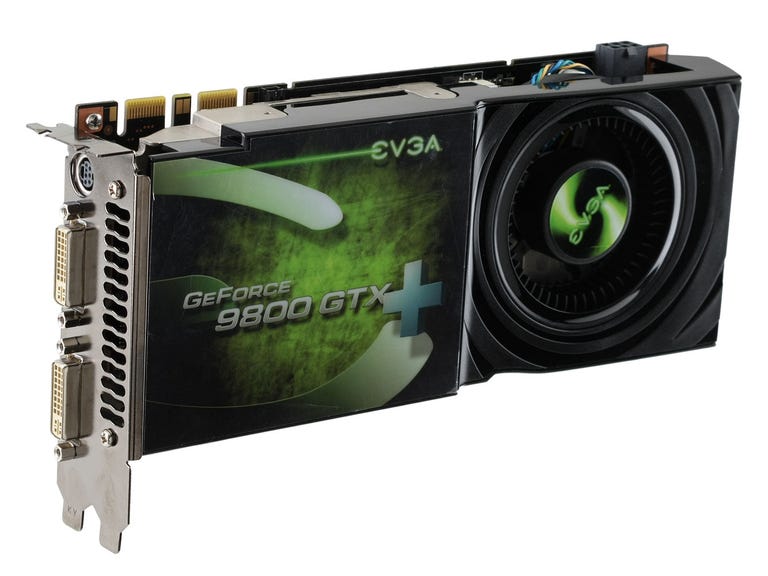 Why You Can Trust CNET
Why You Can Trust CNET EVGA e-GeForce 9800GTX+ Superclocked graphics card - GF 9800 GTX+ - 512 MB review: EVGA e-GeForce 9800GTX+ Superclocked graphics card - GF 9800 GTX+ - 512 MB
EVGA e-GeForce 9800GTX+ Superclocked graphics card - GF 9800 GTX+ - 512 MB
EVGA's Superclocked edition of Nvidia's GeForce GTX 9800+ is a fast 3D graphics card at an affordable price. You can expect it to play most current PC games at smooth frame rates, especially on lower resolutions. We've seen prices as low as $165 and as high as $235, so you would be wise to shop around. And those with limited upgrade room might consider the comparable card from ATI , the Radeon HD 4850 that, unlike the double-wide GeForce GTX 9800+, requires only a single expansion slot. Otherwise, the differences between these two cards, in price, power consumption, and speed are negligible.
The Good
The Bad
The Bottom Line
| EVGA GeForce GTX+ 9800 Superclocked | Diamond Radeon HD 4850 | |
| Price | $165 | $180 |
| Manufacturing process | 55nm | 55nm |
| Core clock | 756MHz | 625MHz |
| Stream processors | 128 | 800 |
| Stream processor clock | 1,836MHz | NA |
| Memory | 512MB | 512MB |
| Memory speed | 1.1GHz | 993MHz |
Nvidia's GeForce GTX 9800+ chip debuted last July for around $230. In this "Superclocked" design from EVGA, Nvidia's chip has its core clock speed boosted to 756MHz, from its stock 738MHz setting. This chip was supposed to be Nvidia's Radeon HD 4850-killer, but as you'll see on our charts, even this overclocked model only barely outperforms its competition.
(Longer bars indicate better performance)
| 1,440 x 900 | 1,680 x 1,050 | 1,920 x 1,200 |
(Longer bars indicate better performance)
| 1,440 x 900 | 1,680 x 1,050 | 1,920 x 1,200 |
We ran some rather aggressive benchmarks on these cards, and for the most part they held up well. The exception, as usual, is Crysis, on which neither card was able to achieve a playable frame rate. Even if the Radeon card was faster on that test than the GeForce, it's still only hitting 20 frames per second on 1,400x960, the lowest resolution we tried. Dropping the detail level down to medium and the anti-aliasing to 2x resulted in frame rates around 35 fps, but still well below the 60 frames per second hallowed ground.
While Crysis remains the most difficult game out there for graphics card testing, our Far Cry 2 and Left4Dead test results provide a better indication of how the cards in this price range will handle current PC games. For Far Cry 2, you can see the two cards are roughly tied on the lower resolutions they favor. On the less difficult Left4Dead even the 1,920x1,200 setting poses little challenge. If you own a 24-inch display with a 1,920x1,200 native resolution and intend to play the more demanding games, we recommend that you spend for a higher-end card to take full advantage of the larger screen size. Otherwise, for the foreseeable future at least, either one of these cards should deliver a smooth, well-detailed gaming experience.
(Shorter bars indicate better performance)
| Load | Idle |
If the performance is basically a wash, we find that each card has an advantage in other areas that might sway your buying decision. Even though it's a double-wide, overclocked card, the EVGA GeForce GTX 9800+ actually uses less power than the Radeon card with your computer idling. With only a 14-watt difference, the GeForce card's edge may be a small one, but if you're prone to leaving your PC on for extended periods of time, it may actually save you a few bucks on your electric bill over the course of a year. As with virtually all 3D cards above $100, each of these cards also need a direct connection to your PC's power supply, specifically a single six-pin PCI-Express power input.
Ironically, because the Radeon card requires only a single expansion slot, it's better suited to smaller PCs than the GeForce GTX 9800+, even though the former requires a bit more power. Both of these cards will work in multicard configurations on supporting motherboards, thanks to SLI from Nvidia and Crossfire from ATI, but we don't normally advocate doubling up on lower-end cards due to scaling issues. Not every game will distribute its workload evenly across two graphics cards, but with one card that's not an issue. For the sake of stability (as well as simpler installation) you're generally better off with a single $400 card then two $200 cards.
Each vendor also claims a handful of advanced features for its graphics technology in general; PhysX game physics support for Nvidia, and both Havoc Physics and DirectX 10.1 support for ATI. With few games that take advantage of either vendors' features in a compelling way thus far, neither can claim superiority with its extras. Each card can also connect to an HDTV over a DVI-to-HDMI adapter, but, as always with this generation of graphics chips, Nvidia requires you to connect your card directly to your audio output to send sound over the HDMI connection. By including an onboard audio processor, ATI has eliminated that intermediary step. That and the single slot may be enough to sway home theater enthusiasts away from the GeForce card.
Test bed configuration
Windows Vista Ultimate SP1 64-bit; 3.2GHz Intel Core i7 965; Intel X58 chipset; 4GB 1,066MHz DDR3 SDRAM; 150GB 10,000rpm Western Digital Raptor hard drive


